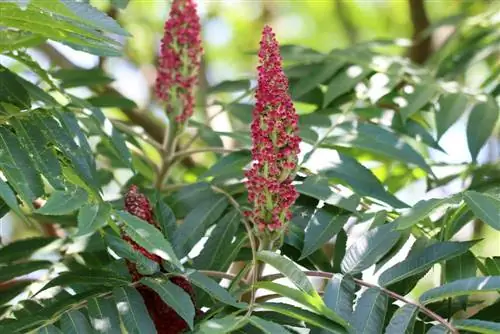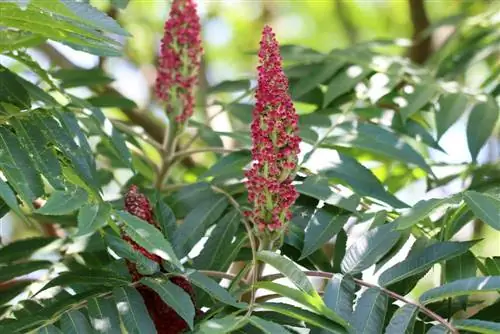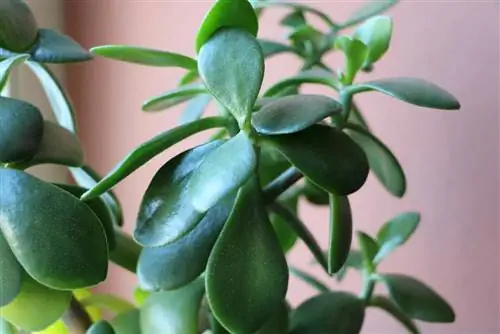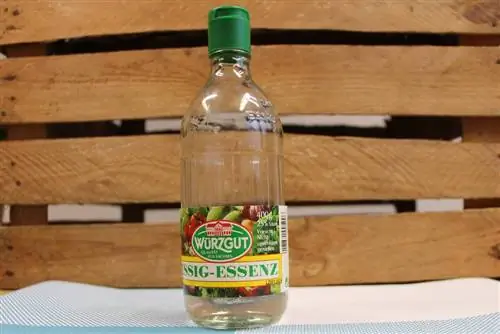- Author admin [email protected].
- Public 2023-12-17 03:39.
- Last modified 2025-01-24 12:45.
Rhus typhina, also known as deer butt sumac, grows as a deciduous shrub or small, multi-stemmed tree with heights of up to 500 cm. It blooms in early summer after the leaves emerge. However, it spreads very widely and can easily displace neighboring plants. But what about the toxicity of this plant, is it poisonous and if so, to whom?
Degree of toxicity disputed
The confusion over the toxicity of Rhus typhina is probably due to other species in the genus Rhus that cause poisoning, such as poison sumac (Rhus toxicodendron). It contains so-called urushiols, which can trigger strong allergic reactions upon contact. No urushiole could be detected in deer butt sumac (Rhus typhina).
It owes its name to the fruits, which contain an acid that tastes like vinegar. While the flowers are not poisonous, the fruits should only be used when processed. They are mainly used dried as a refreshing tea or spice for the production of lemonade “Indian Lemonade” or pickled in vinegar.
The milky juice it contains is particularly poisonous. It can trigger different reactions upon contact and consumption. This affects people as well as dogs, cats, small animals and horses. In most cases it only becomes critical when larger quantities are taken, as it is well known that the dose often determines the toxicity.
Ingredients and effects
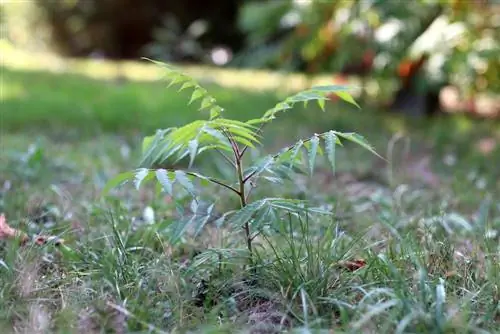
Ingredients include tannins, essential oil, resins, steroids, phenylglycosides and triterpenes. The main active ingredients are tannins, ellagic acid and a strongly acidic cell sap. The actual poisonous effect of the vinegar tree is based on the latter. Depending on the dose, they can cause different symptoms.
Effect on people
- Poisonings mainly caused by the milky sap of plants
- Skin contact can cause skin irritation in sensitive people
- If juice gets into the eyes, it can cause conjunctivitis
- When consumed, the amount of poison is the deciding factor
- Ingestion of large quantities of leaves or fruits is dangerous to he alth
- Symptoms such as stomach pain, diarrhea, nausea, vomiting, headache and dizziness
- In the worst case scenario, kidney and liver damage is possible
- Children as well as older and sick people are particularly at risk
- It is best to avoid contact with this plant
Tip:
Unlike children, he althy adults generally do not have to expect symptoms of poisoning when consuming small quantities.
Help with poisoning
If children are affected, they should definitely be seen by adoctor as soon as possible. In the event of eye contact, it is advisable to consult an ophthalmologist immediately. It is also helpful to call the poison control center.
Danger to domestic and grazing animals
A variety of plants and herbs offer variety in feeding for grazing animals. However, there are some plants that can cause poisoning in animals, such as deer sumac (Rhus typhina). Many plants that are non-toxic to humans can be toxic to animals. The effects can vary from animal species to animal species and affect both domestic and small animals as well as grazing animals, in this case especially horses.
Dogs and cats
Parts of the vinegar tree are slightly poisonous to dogs. Poisoning manifests itself in the form of gastrointestinal problems such as nausea, vomiting and diarrhea. This tree, especially seeds, unripe fruits and roots, poses a greater danger to cats. In addition to gastrointestinal problems, they can also experience paralysis and even death as a result of respiratory or circulatory paralysis. The tannins and acids contained in the plant are primarily responsible for this. If any symptoms occur, you should see a vet.
Hamsters and guinea pigs
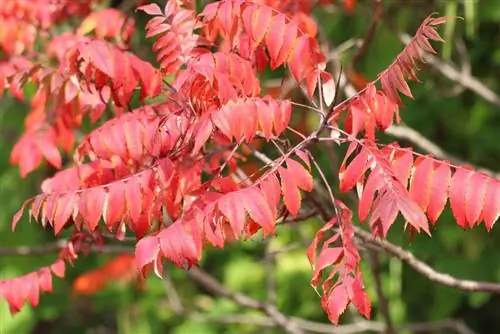
Hamsters, guinea pigs and other small rodents are at similar risk to cats, although rabbits, rats and mice can tolerate significantly higher doses. Depending on the amount consumed, the symptoms can vary in severity. Gastrointestinal problems can occur in cats, hamsters and guinea pigs. In addition, attacks of weakness can occur. A visit to the vet is also recommended for these animals.
Tip:
To make the diagnosis easier for the veterinarian, it is advisable to take part of the plant with you. By the way, this applies to all animal species and all poisoning caused by plants.
Horses and sheep
As far as sheep are concerned, there are no reports of poisoning caused by this plant. If you want to be on the safe side, you should not feed vinegar tree leaves to sheep to be on the safe side. However, they are definitely poisonous to horses. They spend most of the day eating. Due to domestication, most domestic horses have lost their natural instinct to avoid poisonous plants. Poisoning can occur in the pasture or in the stable if plant parts of the vinegar tree accidentally get into the hay.
These can lead to minor or serious he alth problems, especially in horses, and in the worst case even death. Not all animals react the same way; some are much more sensitive than others. A decisive factor here is the he alth and nutritional status of the animals. Of course, poorly fed and sick horses are more sensitive because they have nothing to counteract the poison.
Symptoms and help measures
- In case of poisoning, occurrence of gastrointestinal problems
- Severe colic is also often possible
- Milk juice can also trigger inflammation
- Contact a veterinarian immediately for clarification and treatment
- Provide as much information as possible on the phone
- When the horse ate what and how much of it
- What symptoms it shows, how it behaves
Tip:
If necessary, the veterinarian can give some helpful tips on first aid over the phone. Until he gets there, you should give the animal plenty of water to drink.
Likelihood of confusion
The deer butt sumac (Rhus typhina) is sometimes confused with the tree of heaven (Ailanthus altissima). Both the seeds and the bark of the tree have poisonous potential. The leaves and pollen are also suspected of causing allergies. However, there are clear characteristics that can be used to distinguish between these two trees.
Stag butt sumac (Rhus typina)
- Growth height up to five meters
- 11-31 oblong-lanceolate leaflets
- Edges of the leaflets sawn
- Shoots velvety hairy
- Male flowers with yellowish-green petals
- Female with reddish petals
- Dark red, flask-like fruit cluster
God Tree (Ailanthus altissima)
- Growth height up to thirty meters
- 20-40 leaflets, up to 90 cm long
- Leaf edge has a tooth
- Inflorescence whitish-green
- Intense, unpleasant smell
- Two-sided winged fruit clusters
- Parchment-like, light brown to reddish wings
Tip:
There is also a risk of confusion with the highly poisonous relatives of the vinegar tree from the sumac family such as poison sumac. The non-poisonous common ash tree is also confusingly similar.
Sources:
de.wikipedia.org/wiki/Essigbaum
www.mein-schoener-garten.de/abc/e
www.baumkunde.de/Rhus_typhina/
www.gartenkatalog.de/wiki/ailanthus- altissima
botanikus.de/informatives/giftpflanzen/alle-giftpflanzen/essigbaum/
www.blumen-wandel.net/b%C3%A4ume-str%C3%A4ucher-a-z/g%C3%B6tterbaum/

